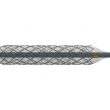Courtesy of Dr. Carlos Fava. Nowadays, the number of coronary angioplasties carried out on patients with chronic total occlusion (CTO) is increasing due to many studies showing that it improves ventricular function, reduces symptoms, and improves survival. However, most of these works do not include patients of over 75 years old due to their frailty and<a href="https://solaci.org/en/2017/06/19/successful-angioplasty-in-elderly-patients-with-chronic-total-occlusion-reduces-mortality/" title="Read more" >...</a>
In-hospital morbid-mortality rates for balloon aortic valvuloplasty are similar to those for transcatheter aortic valve implantation
Courtesy of Dr. Carlos Fava. The balloon aortic valvuloplasty (BAV) was introduced by Dr. Cribier in 1986. However, given its poor results, soon after it fell into disuse. With the introduction of TAVR, it saw a revival as bridge for another intervention, even though it is still resisted in many places. The present study<a href="https://solaci.org/en/2017/06/07/in-hospital-morbid-mortality-rates-for-balloon-aortic-valvuloplasty-are-similar-to-those-for-transcatheter-aortic-valve-implantation/" title="Read more" >...</a>
AIDA: bioresorbable scaffold thrombosis still a concern in studies
Courtesy of the SBHCI. This study presented at PCR and simultaneously published by NEJM still challenges the safety of bioresorbable scaffolds. This was a multicenter noninferiority work carried out in the Netherlands, comparing 1:1 everolimus-eluting bioresorbable scaffold ABSORB and permanent-polymer everolimus-eluting stent Xience. The primary endpoint was target-vessel failure (a composite of cardiac<a href="https://solaci.org/en/2017/06/02/aida-bioresorbable-scaffold-thrombosis-still-a-concern-in-studies/" title="Read more" >...</a>
Bad prognosis for post-MitraClip mitral valve stenosis: how do we proceed?
Courtesy of Dr. Carlos Fava The EVEREST II trial showed the MitraClip had similar mortality rate to that of surgery but, even though residual mitral valve regurgitation (MR) is associated to a strong negative impact, little is known about post MitraClip increased transvalvular gradient and its implication. 268 patients undergoing MC implantation were analyzed.<a href="https://solaci.org/en/2017/05/23/bad-prognosis-for-post-mitraclip-mitral-valve-stenosis-how-do-we-proceed/" title="Read more" >...</a>
Tricuspid valve repair with the MitraClip technique
Current surgical and medical treatment options for severe tricuspid regurgitation are extremely limited. However, this historically forgotten valve seems to have the option of transcatheter repair, nowadays. This observational study assessed the safety and feasibility of the MitraClip system for patients with severe chronic tricuspid regurgitation. All patients presented severe tricuspid regurgitation and<a href="https://solaci.org/en/2017/04/27/tricuspid-valve-repair-with-the-mitraclip-technique/" title="Read more" >...</a>
Bioresorbable scaffolds with drug-eluting stents: do they entail a higher thrombosis risk?
Courtesy of Dr. Leiva. Bioresorbable scaffolds with drug-eluting stents (bioresorbable vascular scaffolds, BVS) have been added to the list of endovascular treatment options for coronary disease. The ABSORB III trial showed the non-inferiority of this stent type to everolimus-eluting metallic stents as regards target-lesion revascularization (TLR) at one year. However, reports have suggested a higher<a href="https://solaci.org/en/2017/04/21/bioresorbable-scaffolds-with-drug-eluting-stents-do-they-entail-a-higher-thrombosis-risk/" title="Read more" >...</a>
Proximal anterior descending artery angioplasty: what are its long-term outcomes?
Courtesy of Dr. Javier Castro. Certain coronary lesions have been historically discouraged for endovascular treatment. Among these can be found left main coronary artery lesions, multivessel disease, and proximal anterior descending artery lesions. As a matter of fact, the latter is actually considered separately as a criterion for choosing the revascularization method. Endovascular treatment of<a href="https://solaci.org/en/2017/04/20/proximal-anterior-descending-artery-angioplasty-what-are-its-long-term-outcomes/" title="Read more" >...</a>
RESOLUTE Global: 5 Years of Zotarolimus DES Stenting
This study assessed the cumulative incidence of cardiovascular evens after zotarolimus eluting stent implantation. Individual studies often lack enough statistical power to show differences in low frequency adverse events. The Resolute zotarolimus eluting stent was evaluated across 10 prospective clinical trials designed with identical adverse events definitions. The Global Resolute clinical trial program<a href="https://solaci.org/en/2017/03/10/resolute-global-5-years-of-zotarolimus-des-stenting/" title="Read more" >...</a>
MitraClip: Impact of Sinus Rhythm and Heart Rate
Courtesy of Dr. Carlos Fava. Atrial fibrillation (AF) and fast heart rate (>70 lpm) have been shown to increase the risk of mitral valve repair surgery. The MitraClip has shown benefits in high risk patients, but its relation to abnormal heart rhythm has not yet been established. 760 patients were analyzed; 315 (52.4%) presented<a href="https://solaci.org/en/2017/03/06/mitraclip-impact-of-sinus-rhythm-and-heart-rate/" title="Read more" >...</a>
Is The Transradial Approach Useful in CTO?
Courtesy of Dr. Carlos Fava. The transradial approach has been advanced in time, and is being increasingly used in more and more complex angioplasty procedures with the same benefit, compared to the classical femoral approach. As a result, in many high volume centers, this reality has demoted the femoral approach to a few particular procedures.<a href="https://solaci.org/en/2017/02/25/is-the-transradial-approach-useful-in-cto/" title="Read more" >...</a>









